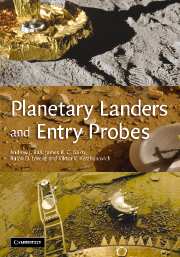Book contents
- Frontmatter
- Contents
- Preface
- Acknowledgements
- List of acronyms and abbreviations
- PART I Engineering issues specific to entry probes, landers or penetrators
- PART II Previous atmosphere/surface vehicles and their payloads
- 15 Destructive impact probes
- 16 Atmospheric entry probes
- 17 Pod landers
- 18 Legged landers
- 19 Payload delivery penetrators
- 20 Small body surface missions
- PART III Case studies
- Appendix Some key parameters for bodies in the Solar System
- Bibliography
- References
- Index
17 - Pod landers
Published online by Cambridge University Press: 12 August 2009
- Frontmatter
- Contents
- Preface
- Acknowledgements
- List of acronyms and abbreviations
- PART I Engineering issues specific to entry probes, landers or penetrators
- PART II Previous atmosphere/surface vehicles and their payloads
- 15 Destructive impact probes
- 16 Atmospheric entry probes
- 17 Pod landers
- 18 Legged landers
- 19 Payload delivery penetrators
- 20 Small body surface missions
- PART III Case studies
- Appendix Some key parameters for bodies in the Solar System
- Bibliography
- References
- Index
Summary
The landers covered in this chapter have the ability to survive an initial landing impact, which may send the vehicle rolling and/or bouncing across the surface, and then commence operations having come to rest in whatever orientation is finally reached. Most achieve this by means of airbags to cushion and dampen the initial impact and subsequent rolling/bouncing motion, followed by the opening out of a system of ‘petals’ to bring the lander itself to its proper orientation for surface operations. The Ranger seismometer capsules are the exception to this; their impact damping was provided by the balsa-wood shell and liquid-bath system surrounding the experimental equipment, and the orientation being achieved by means of the natural position of the equipment within its liquid bath.
Typical payload experiments for such landers include cameras, meteorological, geological, geophysical and environmental sensors for investigation of the landing site. While some can be body-mounted on the probe, others may require deployment by means of masts, arms or a rover. In the case of the Mars Exploration Rovers, the pod landing stage itself plays no further role once the rover has rolled off.
Pod landers are particularly suited to ‘network science’, where simultaneous seismological, meteorological or other geophysical measurements are made at multiple locations. Such a network was the aim of the NetLander mission a network of four Mars landers to be carried on the CNES-led Mars Premier mission. The mission was cancelled in 2003 towards the end of Phase B of the project, however.
Information
- Type
- Chapter
- Information
- Planetary Landers and Entry Probes , pp. 177 - 198Publisher: Cambridge University PressPrint publication year: 2007
